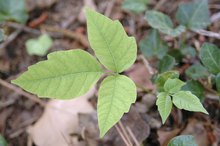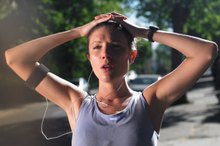Lupus & Flushed Face During Exercise
Lupus is an autoimmune disease that can cause inflammation in your joints, skin and major organs. Although there is no cure, symptoms can be treated with medication. Regular, moderate exercise is also beneficial. While a flushed face is a common consequence of exercise -- both for people who have lupus and those who do not -- a butterfly-shaped flush across your cheeks and nose is a classic lupus symptom. Its appearance may indicate that a flare -- or worsening of symptoms -- is imminent.
If you are experiencing serious medical symptoms, seek emergency treatment immediately.
Lupus Features
The most common -- and the most serious -- form of lupus is systemic lupus erythematosus, or SLE 1. Symptoms can range from mild to severe, with the disease flaring up and subsiding unpredictably. In addition to the characteristic butterfly-shaped facial rash, signs of lupus can include joint pain; fatigue; fever; changes in weight; hair loss; shortness of breath; and a tendency to bruise easily. You may also experience anxiety, depression, confusion and memory loss. Complications from lupus can be serious and may include kidney damage, cognitive dysfunction and increased cancer risk. The cause of lupus is unknown; genetics and environment may play a role. Your doctor may prescribe corticosteroids, anti-inflammatory drugs, or immunosuppressive drugs. MayoClinic.com reports that exposure to both sunlight and fluorescent light can trigger a flare; infections and certain medications can also act as triggers.
- The most common -- and the most serious -- form of lupus is systemic lupus erythematosus, or SLE 1.
- The cause of lupus is unknown; genetics and environment may play a role.
Butterfly Rash
What Are the Causes of Intense Painful Itching?
Learn More
According to a 2002 article in "American Family Physician," 90 percent of lupus patients eventually display symptoms on skin. Butterfly rash -- medically known as malar rash -- can be either flat or raised and may range in intensity from a faint flush to a deep crimson discoloration. Although it is usually painless, some patients report itching or burning. Your doctor may prescribe a steroid cream to treat the rash.
- According to a 2002 article in "American Family Physician," 90 percent of lupus patients eventually display symptoms on skin.
- Although it is usually painless, some patients report itching or burning.
Flushing During Exercise
General facial flushing during exercise is caused by the dilation of your blood vessels because of increased circulation. Facial flushing can also result from sunburn. According to the Lupus Foundation of America, two-thirds of lupus sufferers have increased sensitivity to ultraviolet rays. If you have not been diagnosed with lupus and notice flushing and redness in a butterfly pattern on your face during exercise, consult your doctor. If you have been diagnosed with lupus, call your doctor if a butterfly rash appears on your face during exercise; it may signal an oncoming flare. If you already have a butterfly rash, the increased blood flow to your face caused by exercise can make it more visible.
- General facial flushing during exercise is caused by the dilation of your blood vessels because of increased circulation.
- If you already have a butterfly rash, the increased blood flow to your face caused by exercise can make it more visible.
Exercise Considerations
Little Red Dots on My Legs After Exercise
Learn More
Even though exercise may make your rash temporarily more noticeable, it carries substantial benefits. The Lupus Foundation of America recommends regular, moderate exercise to help strengthen bones, tone muscles, improve flexibility and range of motion, and help to relieve the stress, depression and fatigue that can accompany lupus. According to "American Family Physician," obesity and high blood pressure are associated with lupus; exercise can help reduce your risk of these conditions. MayoClinic.com recommends 30 minutes of aerobic activity most days of the week. The LFA advises walking, swimming, bicycling, and light resistance training. Protect yourself from heat and excessive sun by exercising indoors, or schedule workouts for early morning and evening. Always use a sunscreen with an SPF of at least 30; a broad-brimmed hat can provide further protection. Before beginning an exercise routine for lupus, consult your doctor.
- Even though exercise may make your rash temporarily more noticeable, it carries substantial benefits.
- The Lupus Foundation of America recommends regular, moderate exercise to help strengthen bones, tone muscles, improve flexibility and range of motion, and help to relieve the stress, depression and fatigue that can accompany lupus.
Related Articles
References
- American Family Physician; Treatment of Systemic Lupus Erythematosus; Michelle Petri, M.D., M.P.H., June 1998
- Centers for Disease Control and Prevention. Systemic lupus erythematosus (SLE). Updated October 17, 2018.
- Lupus Foundation of America. Lupus facts and statistics. Updated October 6, 2016.
- Centers for Disease Control and Prevention. Lupus in women. Updated October 17, 2018.
- Maidhof W, Hilas O. Lupus: an overview of the disease and management options. P T. 2012;37(4):240-9.
- Lupus Foundation of America. Lupus facts and statistics. Updated October 6, 2016.
- Lupus Foundation of America. About cutaneous lupus. Updated July 12, 2013.
- Barbhaiya M, Costenbader KH. Environmental exposures and the development of systemic lupus erythematosus. Curr Opin Rheumatol. 2016;28(5):497-505. doi:10.1097/BOR.0000000000000318
- Grönhagen CM, Nyberg F. Cutaneous lupus erythematosus: An update. Indian Dermatol Online J. 2014;5(1):7-13. doi:10.4103/2229-5178.126020
- Johns Hopkins Lupus Center. Lupus-specific skin disease and skin problems.
- Centers for Disease Control and Prevention. Lupus symptoms. Updated October 17, 2018.
- Harley JB, Chen X, Pujato M, et al. Transcription factors operate across disease loci, with EBNA2 implicated in autoimmunity. Nat Genet. 2018;50(5):699-707. doi:10.1038/s41588-018-0102-3
- Centers for Disease Control and Prevention. Diagnosing and treating lupus. Updated October 17, 2018.
- Lupus Foundation of America. Medications used to treat lupus. Updated July 12, 2013.
- Navarrete-navarrete N, Peralta-ramírez MI, Sabio-sánchez JM, et al. Efficacy of cognitive behavioural therapy for the treatment of chronic stress in patients with lupus erythematosus: a randomized controlled trial. Psychother Psychosom. 2010;79(2):107-15. doi:10.1159/000276370
- Greco CM, Nakajima C, Manzi S. Updated review of complementary and alternative medicine treatments for systemic lupus erythematosus. Curr Rheumatol Rep. 2013;15(11):378. doi:10.1007/s11926-013-0378-3
- Lupus Foundation of America. Smoking and lupus: It's never too late to quit.
- Zhang L, Fu T, Yin R, Zhang Q, Shen B. Prevalence of depression and anxiety in systemic lupus erythematosus: a systematic review and meta-analysis. BMC Psychiatry. 2017;17(1):70. doi:10.1186/s12888-017-1234-1
- Olesińska M, Saletra A. Quality of life in systemic lupus erythematosus and its measurement. Reumatologia. 2018;56(1):45-54. doi:10.5114/reum.2018.74750
- Maidhof W, Hilas O. Lupus: an overview of the disease and management options. P T. 2012;37(4):240-9.
- Lupus Foundation of America. How Lupus Affects the Skin.
Writer Bio
Carol Sarao is an entertainment and lifestyle writer whose articles have appeared in Atlantic City Weekly, The Women's Newspaper of Princeton, and New Millennium Writings. She has interviewed and reviewed many national recording acts, among them Everclear, Live, and Alice Cooper, and received her Master of Fine Arts degree in writing from Warren Wilson College.









